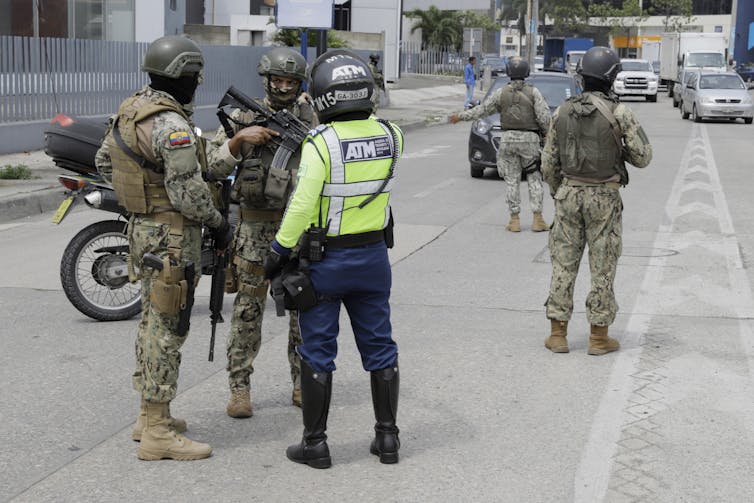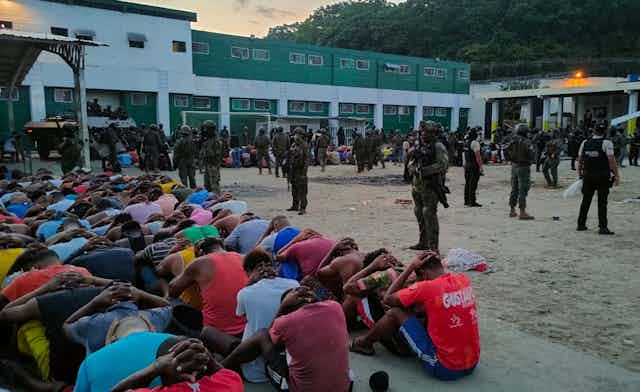An unprecedented surge in violence in Ecuador recently has captured global attention, especially after a gang took control of a television station during a live broadcast on January 9. Once considered to be a haven for peace and stability in the region, as of 2023 Ecuador has earned the infamous distinction of being the most violent country in Latin America.
The recent gang violence in Ecuador is just a symptom of a deeper issue affecting countries across the region. The unrest is rooted in the erosion of state capacity as a result of government austerity measures across Latin America. It has created fertile ground for the growth of criminal gangs.
Austerity, the recipe adopted by recent governments in Ecuador, has enmeshed the country into global financial capital networks, compromising its sovereignty. As the painful consequences of austerity have become evident, the state now is inviting foreign military intervention and has signed an agreement with Washington for the permanent deployment of US troops in the country.
But austerity alone does not explain the escalation of violence. There are other variables that should be considered. One of them is financial deregulation as part of increased capital needs of dollarisation. As Ecuador adopted the US dollar as its currency, it made foreign investors more likely to invest in the country.
However, dollarisation facilitated also money laundering, and made Ecuador appealing for drug traffickers and international mafias. It is no surprise that Ecuador is now the primary conduit for the shipment of cocaine to Europe from across the region.
Meanwhile, the declaration of an “internal armed conflict” by the current administration may align with the Ecuadorean people’s plea for immediate solutions. But this tends to obscure the responsibility for the failure of previous and current governments in dealing with structural violence.
Looking at the past to understand the present
Regrettably, the current challenges in Ecuador partly stem from efforts to address criminality. For example, during the administration of Rafael Correa between 2012 and 2017, there was a surge in the prison populations.
This had the unintended effect of prisons evolving into focal points for criminal organisations. They have duly become centres for networking between criminals and dubbed “universities of crime”. They host a spectrum of illicit activities, fostering coordination among various criminal organisations.
Meanwhile, violence decreased, the ties between criminal organisations and some state actors grew stronger. Ironically, during Correa’s administration, efforts to combat narco politics coincided with the rise of “Los Choneros”, Ecuador’s leading drug-trafficking gang.
The escape of the Los Choneros leader known as “Fito”“ this month exemplifies the depth of the problem, revealing the power of organised crime both inside and outside prisons.
After the election of Correa’s vice-president, Lenín Moreno, to the presidency from 2017 to 2021, the previous equilibrium with between some state actors and criminal networks seems to have changed. This has resulted in chaos in prisons and violence spilling on to the streets.
The situation was exacerbated by widespread social turmoil. During this period as a result of austerity measures, and the shocks due to the pandemic precarity increased.
Guillermo Lasso’s government -between 2021 and 2023, declared a war on drugs, leading to a surge in homicides. This shift towards a militarised approach achieved a limited success in eradicating gang violence, and exhibited authoritarian responses against the social protests denouncing the reduction of the social protection in the country.

In declaring an internal armed conflict, the current president Daniel Noboa’s strategy echoes the approach taken by El Salvador’s president Nayib Bukele. This approach echoes the experiences of Colombia’s attempts to to combat violence by using the figure of a state of emergency.
The declaration of "internal war”, aligning with the population’s desperate need for immediate solutions to tackle insecurity, gives more authority to military forces, but it lacks an strategy beyond the promise to defeat armed groups.
The militarisation of public security can lead to an escalation in the violence as criminal groups will more likely respond to violence in kind. This escalation, can lead to a cycle of violence and repression in which civilians will inevitably end up in the crossfire of multiple armed actors.
Poverty, precarity and the explosion of violence
The focus on violence overshadows what makes easier for armed groups to recruit cadres: the precarity of marginalised communities. For example, the national poverty rate has been on an upward trend from 24,5% in 2018 to to 27% in 2023. This phenomenon has disproportionately hit historically marginalised groups in the country (Indigenous people, Afro-Ecuadorians, and Montuvians), with almost 50% of these communities living in poverty. Yet, these same marginalised communities and the vulnerable youth are now facing vilification for being more vulnerable to being recruited by gangs.

The COVID pandemic made things much worse for many of these communities, making them even more susceptible to poverty or recruitment into armed groups.
The recruitment of marginalised youth into criminal gangs sheds light on how austerity and external shocks are fuelling the growth of illicit activities. Increased precarity after the pandemic, withdrawing social protection, individualism and the glamourisation of criminal figures in the media, have contributed to the erosion of the social fabric. This in turn has facilitated the recruitment of people into organised crime.
The crisis of violence has unfolded in tandem with the retreat of the state in guaranteeing social and economic rights. While, armed groups emerge where states are seen as less legitimate, we must remember that the source of legitimacy of a state cannot be derived solely from violence.
The response to this crisis necessitates a strong state that can challenge armed groups on multiple fronts: the monopoly of violence and the welfare of the population. Stability entails the commitment to providing protection beyond just meeting violence with violence. In the 21st century, legitimacy cannot be dictated by raw violence alone.

